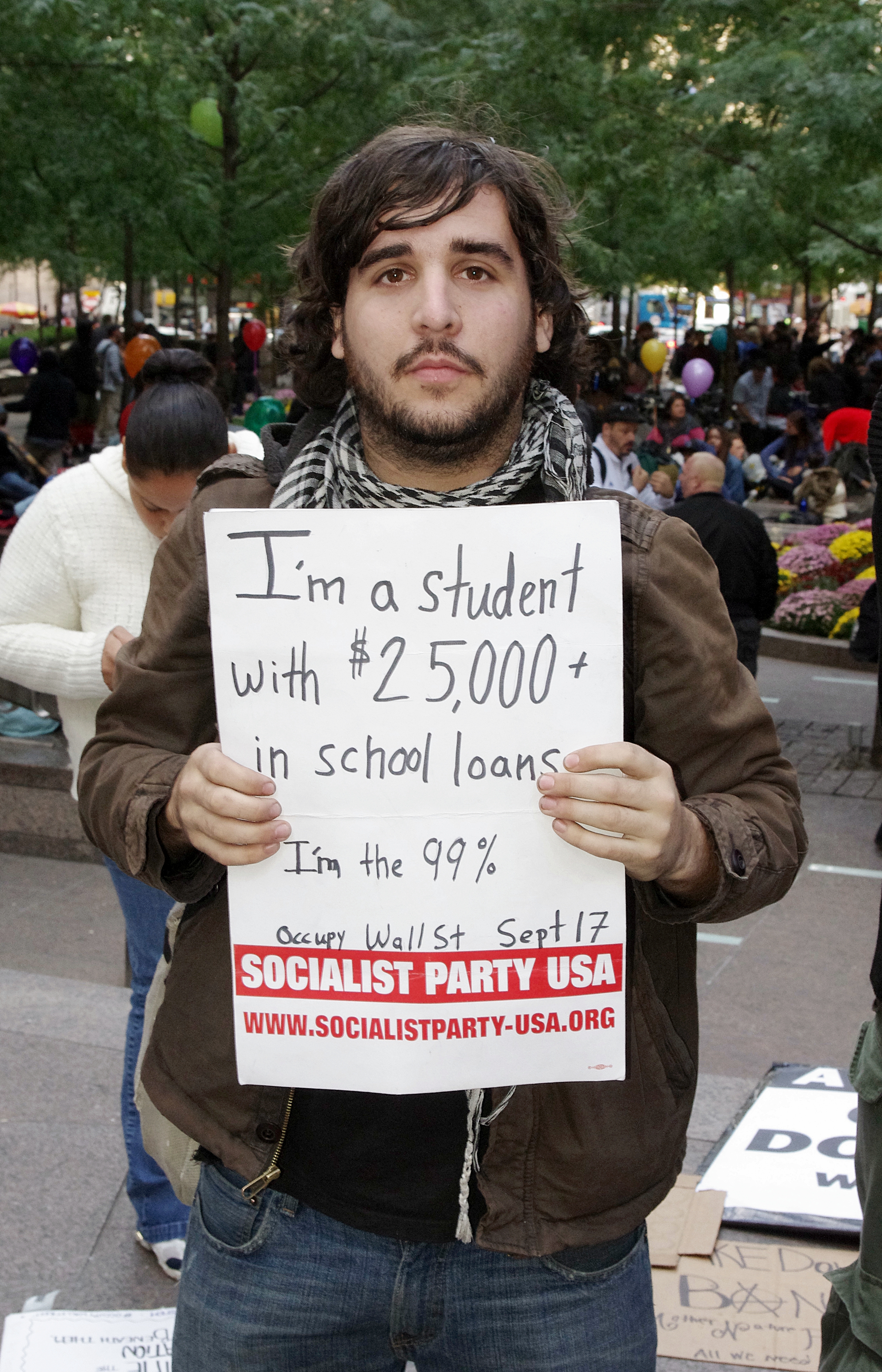
The state of US student debt, as presented by a participant on Day 3 of the protest Occupy Wall Street in Manhattan's Zuccotti Park. Photo by David Shankbone (CC BY 3.0)
When I was 17, and applying to university, my parents told me we’d be splitting the cost. For me, and for them, this meant taking out US federal loans that would be repaid over the next decade or more.
I was relatively lucky. As a lower-income student, I was eligible for a federal Pell Grant, and was accepted into an excellent state university which, at the time, cost just a little more than $10,000 per year in tuition fees. I kept my debt down by working part-time to cover expenses, and was grateful for any help my parents could offer. After graduating from university, I participated in a year-long national service program, earning a $5,000 award that went toward repaying my loans.
In the end, it took me eleven years to repay my student loans. I made my final payment on July 3 of this year.
Today, US students leave university with an average of $29,000 in debt. That figure goes up for students who attend universities in larger cities—the average graduate in Washington, D.C. carries a whopping $41,000 of student loan debt.
This state of affairs has led to what many pundits and scholars in the US are calling a “crisis,” with those hardest hit often students with smaller debts but dismal job prospects. For young graduates, the unemployment rate last year was 8.5%. The math is simple: If recent graduates can’t get jobs, they can’t repay their loans.
Shortly after I moved to Germany in 2014, the state of Lower Saxony became the last region to nix tuition fees, making university education free for all, including non-citizens. Several other European countries (such as Finland and Slovenia) offer free university education, as do Brazil and Argentina.
It’s hard to underestimate what this idea means to an American. From the time we’re old enough to dream about college, those of us without means are also worrying about how we’ll pay for it, while others can’t fathom being able to scrape together enough just to afford the down payments. In a country where 1.2 million primary and secondary school students are homeless, a college education is an extraordinary privilege.
Although the Obama administration has made significant changes to the way student loans work, for many, it’s still not enough. A four-year university education in the US costs between $40,000 per year on the low end (for a student attending a public university in his or her home state) to more than $125,000 for students attending private universities—and that’s only tuition fees. Add to that the cost of housing and other life necessities, and it’s no surprise that students are opting out altogether. Which is fine—so long as it’s truly a choice.
But in today’s economic environment, it really isn’t. Last year, university enrollment in the US fell by nearly half a million. Economists say that when the economy is doing well, fewer people attend colleges and universities, but when it isn’t, higher education becomes a “safe harbor.” In other words, young people are choosing the most likely path to self-sufficiency.
And yet, with so many jobs requiring a four-year degree, despite the high cost of attendance, not attending university can, in the long run, cost so much more in lost wages. The Pew Research Center estimates the earning gap between a high school graduate and a graduate of a four-year college or university is around $17,500.
We should all be able to choose our own path. University isn’t for everyone, nor should it be. But the choice, the ability to attend should absolutely be a right extended to all, without the burden of decades of debt.








5 comments
My husband works as an engineer at a well-known tech company. He has $86K in grad school debt at 6.8 and 7.2%. Many of the H1Bs he works with went to school in Europe at little or no cost. The foreign workers are buying houses and cars and sending their kids to the best private schools. These are things we could never afford, even with top-notch American educations.
I’m $180,000 in debt at 9% interest. It will never be paid back. The ‘money’ which the department of education created out of thin air went right to the executives at ITT Tech just like all the other predatory schools and I saw no benefit whatsoever from the degree. There is a closed door system between these schools, Sallie Mae, and the department of education that must change for any meaningful change to this problem. The all have a conflict of interest in preventing huge debt burdens and life long destruction from debt.
I agree that changes need made. Are major start would be capping interest rates at 10 year treasury rates. But instate rates at state schools are around 10K add another 10 for room and board. Not 40000
Frankly I think all student loan debt for everyone should be forgive and any student who needs to go to college should have their way paid by the US Gov without a payback.. To pay for that, the US gov should stop bombing in the Middle East for a day or for a week out of every month and put the savings into whatever usurious organization is killing the economic opportunities of our own children while foreign children go to our colleges and universities because they now can afford the costs..